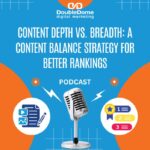By admin

You don’t want to spread yourself too thin by covering everything superficially — but you also can’t dominate a niche if your content is overly narrow. That’s where a content balance strategy comes in: combining depth and breadth to build authority, relevance, and reach. In this episode, we’ll explore how to craft a content approach that satisfies both users and search engines.
Key Takeaways
-
Depth vs. Breadth: What’s the Difference?
-
Breadth means covering many topics and keywords across your industry — casting a wide net.
-
Depth means going deep on a few core topics — creating pillar content that becomes a go-to resource.
-
-
Why Relying on Just One Fails
Too much breadth can make your content feel shallow and lack authority. Too much depth without variety can limit your visibility and miss capturing related search queries. The balance is key. -
How to Build a Balanced Content Ecosystem
-
Create Pillar Content (Depth): Start with your core services or strategic themes. Build long guides or comprehensive pages that thoroughly explore each pillar topic.
-
Develop Cluster Content (Breadth): Around each pillar, produce shorter articles on subtopics, linking back to the pillar. This widens your keyword reach and reinforces topic relevance.
-
Audit & Adjust Continuously: Identify gaps where breadth is missing or where pillar pages need enriching. Refresh, expand, or create new content as needed.
-
-
Benefits You Get from a Smart Balance
When done well, a content balance strategy improves your domain authority, captures more search queries, and attracts better-qualified traffic — not just more traffic.
Final Thoughts
A successful content balance strategy is about being both broad and deep. It’s about building content that shows breadth across your field while also having pillars of depth that showcase expertise. This hybrid approach turns your content into a sustainable advantage.
Ready to Build Your Balanced Content Blueprint?
Start applying a content balance strategy today: select your core pillars, build depth there, and map out associated cluster topics. Audit existing content for gaps in either dimension and begin filling them. If you’d like help designing your content ecosystem or optimizing for both reach and authority, let’s build it together.








